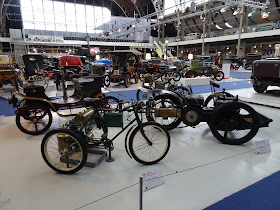
Brussels Autoworld is situated in the Parc de Cinquantenaire exhibition centre. The Cinquantenaire Parc has two 19th century exhibition halls. One hall is given over to the Autoworld and the other the Belgian Military and Aeronautical Museums. Both museums are excellent and well worth half a day visit. https://autoworld.be/home

Within it's massive hall is an excellent collection of historic automobiles, ranging from the earliest years of motoring, right through to modern classics. Belgium may no longer have a motoring industry, it did during the veteran and vintage eras and classic

To the immediate left of the entrance is the veteran section.

1906 Lion-Peugeot VA.

1904 Curved Dash Oldsmobile from the US. Although Henry Ford is commonly credited with pioneering the production line, he actually borrowed the concept from other industries. In fact, Oldsmobile pioneered the concept for automobiles with the CD. These archaic looking 'high wheelers' were popular in the rural US due to their high ground clearance and good suspension.

De Dion Bouton tricycle of 1899.

De Dion Bouton 3HP 1902

1906 Cadillac Model F

Benz Victoria vis a vis


1900 Jean Piat

1898 Lacroix & Delaville 'La Nef'

Triporter

Motorcycle display

Ariel with sidecar

Delivery truck

Vintage garage versus....

A modern garage.
The Vintage Section

1907 Darmont Type D5. Like the British Morgan company, Darmont built tricycle cyclecars powered by motorcycle engines.

1911 Rochet-Schneider

1929 Voisin Type C-14

1925 Chevrolet

1925 Opel

Austin Seven, an early British car for the masses.

Austin Swallow.

1927 Ford Model T sportster.

1925 Voison C5

Cadillac V8

1926 Rolls-Royce Phantom I

Type 49 Bugatti

1933 Lancia Astura

Mercedes-Benz 170 cabriolet.

Ravel. A very rare, small volume French producer. https://www.motorsportmagazine.com/archive/article/march-1994/68/ravel

1920 Bugatti Type 23. Bugatti is known for its luxury and sports cars, but Bugatti started with small, relatively budget cars that were developed from the Peugeot Baby.

On the left is the 1927 Bugatti Type 44

1925 Bentley

Hanomag 2/10 'Kommisbrot.' Hanomag manufactured steam and diesel trains and tractors before branching out into automobiles with the Kommisbrot in 1925. The little car was groundbreaking in several ways. The single cylinder 400cc four stroke engine was placed over the rear axle. This gave the car surprisingly good road handling for a budget car. German auto engineer, Josef Ganz, purchased an example and wrote about it extensively in the pages of Motor Kritic, doing much to popularize the idea. The car also featured something akin to ponton style bodywork.

Packard

1911 Sizarre-Naudin. The Percy Markham Collection once featured one of these cars. It was sold off in the controversial sale and left Australian shores. https://heinkelscooter.blogspot.com/2011/06/percy-markham-collection.html

1913 Alva Type C13

1911 Franklin Model D. The American Franklin was a pioneer of air-cooled engines.

A French Delahaye T108 14CV and American Detroit Electric.

1910 Opel 4/8 PS.

De Dion Bouton of the Edwardian period. Despite being an automotive pioneer, the company stagnated in the 1920s, eventually disappearing from the motoring scene.

The Peugeot Baby T16 was designed by Ettore Bugatti, who went on to found his own eponymous company. Like the Wanderer Puppchen, it was an effective two seater budget car.

1911 Le Zebre Type A4.

1908 Renault X-1. This was the type used to ferry troops from Paris to the Battle of the Marne in 1914.

1912 De Dion Bouton Type DE2 Coupe. Behind the De Dion is a Delage, which looks similar to the example formerly in the Percy Markham. https://heinkelscooter.blogspot.com/2013/10/percy-markham-collection-auction.html


1913 Darracq Type 13 and a Clement Bayard. There is a Clement Bayard at the York Motor Museum. https://heinkelscooter.blogspot.com/2019/06/york-motor-museum-visit-2019.html

1911 Rolls-Royce Silver Ghost, 1913 Studebaker and 1913 Wander Puppchen

1913 Studebaker

1915 Wanderer Puppchen. Wanderer started building typewriters and bicycles in the late 19th century before moving into motorcycles. In 1911 they made the jump to automobiles with the Puppchen. The Puppchen was a pleasant and popular small car seating two in tandem.

1914 Panhard Levassor Type 26. The French Panhard and Levassor was a pioneer of automobile design. They developed the 'Panhard System' of front mounted engine and rear wheel drive and the 'Panhard Rod' suspension system, both of which remain standard to this day.

1911 Peugeot landau body

1915 Benz

Another air cooled Franklin

1921 Renault IG and Citroen Type B

1925 Citroen Type C Torpedo

1925 Renault CV Torpedo

Model T Ford with a caravan body

1920 Model T Ford

1922 Daimler TS 6 30

1925 Studebaker V8

1935 Hispano-Suiza Type K6

On the left an Adler Trumpf and right, a 1939 Horch 930V

1939 Adler Trumpf Junior and a Mercedes Benz


Delahaye

1934 Citroen Traction Avant

The 1899 electric La Jamais Contente (Never Satisfied) record car designed and built by Belgian automotive pioneer, Camille Jenatzy. The La Jamais Contente was the first vehicle in the world to break the 100 KPH barrier.

US cars. 1935 Chrysler Airstream


1937 Panhard and Levassor Dynamic

This is going to be an ongoing post as there are lots more photos to add. Keep an eye on the post for updates.
For photos of our original visit, see here: https://heinkelscooter.blogspot.com/2011/05/brussels-autoworld.html
No comments:
Post a Comment